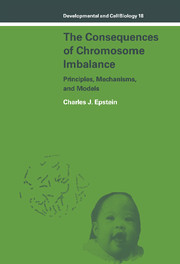Book contents
- Frontmatter
- Contents
- Preface
- Glossary
- PART I INTRODUCTION
- PART II CLINICAL OBSERVATIONS
- PART III THE THEORETICAL MECHANISMS AND ISSUES: THE PRIMARY AND SECONDARY EFFECTS OF ANEUPLOIDY
- PART IV EXPERIMENTAL SYSTEMS FOR THE STUDY OF MAMMALIAN AND HUMAN ANEUPLOIDY
- 10 Generation and properties of mouse aneuploids
- 11 Models for human aneuploidy
- PART V THREE MAJOR CLINICAL PROBLEMS OF HUMAN ANEUPLOIDY
- PART VI CONCLUSION
- Appendix: Standard karyotypes of man and mouse and human cytogenetic nomenclature
- References
- Index
10 - Generation and properties of mouse aneuploids
Published online by Cambridge University Press: 14 October 2009
- Frontmatter
- Contents
- Preface
- Glossary
- PART I INTRODUCTION
- PART II CLINICAL OBSERVATIONS
- PART III THE THEORETICAL MECHANISMS AND ISSUES: THE PRIMARY AND SECONDARY EFFECTS OF ANEUPLOIDY
- PART IV EXPERIMENTAL SYSTEMS FOR THE STUDY OF MAMMALIAN AND HUMAN ANEUPLOIDY
- 10 Generation and properties of mouse aneuploids
- 11 Models for human aneuploidy
- PART V THREE MAJOR CLINICAL PROBLEMS OF HUMAN ANEUPLOIDY
- PART VI CONCLUSION
- Appendix: Standard karyotypes of man and mouse and human cytogenetic nomenclature
- References
- Index
Summary
In the preceding part, several references were made to experimental systems for studying various aspects of the known or potential effects of aneuploidy and polyploidy. In addition to man himself, mention has been made of a number of organisms, ranging from bacteria, yeast, and plants to Drosophila, amphibians, and the mouse. Not already mentioned are also nematodes (Meneely and Wood, 1984), fish (Davisson, Wright, and Atherton, 1972), birds (Bloom, 1972; Blazak and Fechheimer, 1981; Macera and Bloom, 1981), and amphibians (with aneuploidy as opposed to polyploidy) (Guillemin, 1980a, b). However, in only three nonhuman organisms – plants, Drosophila, and the mouse – has the work been part of a systematic investigation of the effects of aneuploidy, and of these organisms only the mouse can be considered as being reasonably close to man genetically, developmentally, and physiologically. Therefore, while the other organisms, as well as others not mentioned or yet used for research on aneuploidy, will continue to be or may become quite useful for the investigation of various aspects of the aneuploidy problem, it is the mouse that promises to be the most useful in the short run. For this reason, separate consideration of the mouse as an experimental system for studying aneuploidy is warranted. Since this subject has been extensively reviewed quite recently (Epstein, 1981a, 1985a, b; Epstein et al., 1984; Gropp et al., 1983), the aim of this chapter will be to highlight and summarize the major findings.
- Type
- Chapter
- Information
- The Consequences of Chromosome ImbalancePrinciples, Mechanisms, and Models, pp. 207 - 234Publisher: Cambridge University PressPrint publication year: 1986
- 1
- Cited by



